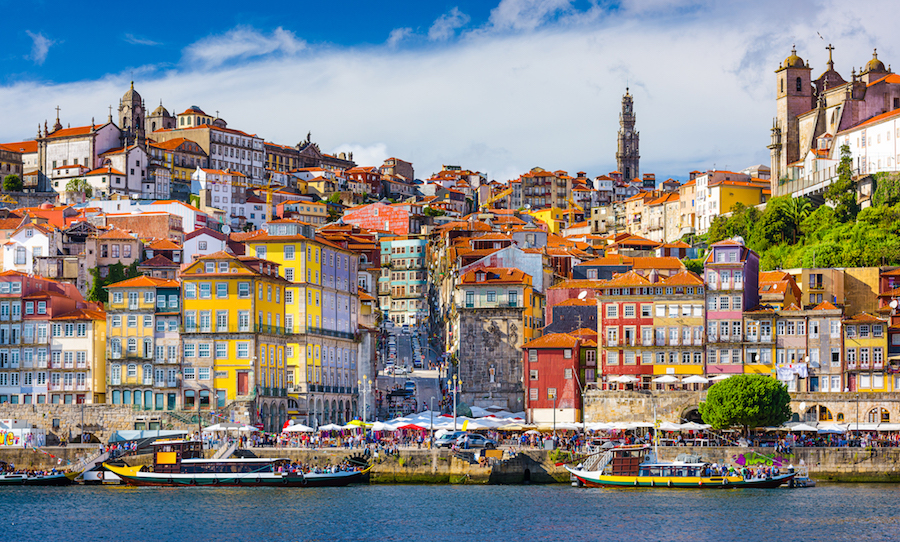Portugal named Europe’s ‘leading tourism destination’: Here’s what to eat and drink there
Portugal is a foodie’s paradise.
For the first time, Portugal has won the award for Europe’s Leading Tourism Destination at the World Travel Awards, for its “diversity of landscapes and welcoming spirit of the Portuguese people”.
Portugal also won the most awards overall at the ceremony held in St. Petersburg, including Europe’s leading cruise port (Lisbon), Europe’s leading island destination (Madeira), Europe’s leading beach destination (Algarve) and Europe’s leading tourist board (Turismo de Portugal).
There’s so much more to Portugal than popular Algarve beaches – medieval castles and palaces in Sintra and Évora, stunning scenery in the Parque Natural Da Serra Da Estrela, and wild, unspoilt (and empty) beaches down the Alentejo coastline. Whatever area you visit though, Portugal has some incredible, underrated local produce.
Pork
The vast, warm, dry Alentejo north of the Algarve is a very fertile region and totally food-orientated. Alentejo pork from the ‘Porto Preto’ breed (also called black pork) is soft-as-you-like, packed with a crazy amount of flavour, and can be found in some of the best fine dining restaurants around the country. It’s also used to make delicious pata negra. In Serra Da Estrela, further north in the Beiras region, wild boar is abundant and often slow cooked in wine.
Seafood
With 1,115 miles of coastline, seafood is integral to Portuguese culture. Everything from sea bass, tuna, squid, octopus and sardines is usually caught wild, rather than in fish farms, and it’s good value for money, even notoriously pricey turbot. Meanwhile, in areas of higher altitude, like the Beiras region, trout is fished from the rivers.
Sheep cheese
Portugal produces several excellent sheep (Ovelha) cheese varieties. Queijo de Évora, made from raw sheep’s milk in the south, is worth travelling to Portugal for alone. Sharp and almost spicy as it ages, it goes very well with homemade pumpkin jam. A creamier variety, Queijo da Serra da Estrela, is known as the ‘king of Portuguese cheese’ and has been made by shepherds roaming their sheep in the mountains of the largest national park in the country for centuries.
Francesinha
If you’re on a diet, you might want to skip this one out. Francesinha, a legendary dish from Porto, is an adaptation of the croque monsieur (it means ‘Frenchie’). The doorstep sandwich is made up of layers of pork, smoked sausage, bacon and beef between slices of bread, topped with a fried egg and coated in a thick cheesy sauce and drenched in thick sauce made from tomatoes and beer. Healthy it is not, but it’s cheap and tasty.
Pastel de nata
Good luck going to Portugal and not eating three pastel de nata a day. The humble custard tart is in every pastry and coffee shop window in Lisbon. It’s made with layers of crispy puff pastry on the outside and sweet, creamy set custard inside, caramelised on top. The recipe apparently dates back 300 years when monks made the tarts to support their monastery and the recipe was sold to the Pastéis de Belém bakery in 1834, who still make them today.
Red Douro Valley wine
Portugal isn’t traditionally known for its wines because the vast majority isn’t exported (although you might have noticed the Portuguese wine section of your local wine shop increasing recently), but when you’re inside the country, you won’t drink much else – and you don’t need to. Wine has been made in the rugged, hilly Douro region in the north for 2,000 years, with many vines planted on steep terraces. There’s a huge selection of local grape varieties and it’s best known for its full-bodied reds.
Port
Porto, of course, is the birthplace of Port and the city is steeped in its history. Port wine is produced deep in the Douro region, hundreds of miles away from the merchants in Porto, so barrels were traditionally carried down the Douro river by boat. Many of the major port houses, like Taylor’s and Cockburn’s, were actually founded by the English, with bottles shipped back to the UK. Today the city is packed with intimate wine cellars where you can order a selection of ports and cheeses, and all the major port houses offer tours and tastings. Try white port and tonic if you find tawny or ruby port too strong.
Green wine
Portugal is the only producer of Vinho Verde, or green wine. It’s made in the colder, rainy Minho province in the far north of the country using younger grapes. Green isn’t referring to the colour, rather the ‘freshness’ or ‘youth’ and, as a result, it’s acidic with a slight hint of fizz. The way it’s produced means that the alcohol content is less, typically 9%, which makes it the perfect daytime tipple.
The Press Association
Latest posts by The Press Association (see all)
- 8 things your feet can tell you about your health - January 8, 2025
- 9 ways to look after your emotional health better in 2025 - January 7, 2025
- EastEnders fans to vote on storyline for the first time in 40th anniversary week - January 7, 2025
- Aldi beats rival Lidl as cheapest supermarket of 2024 - January 6, 2025
- All the benefits of lifting weights beyond bigger muscles - January 6, 2025





















